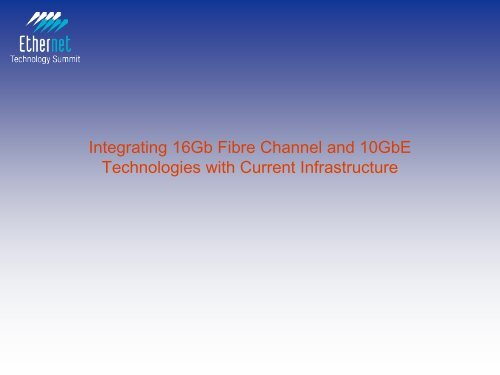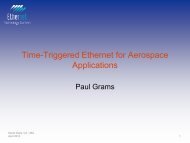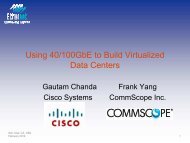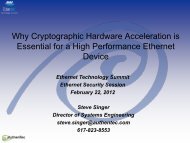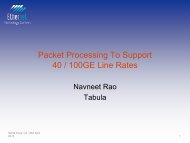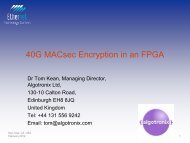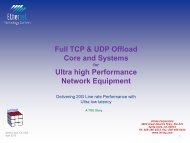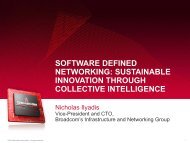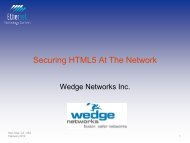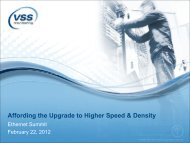Integrating 16Gb Fibre Channel and 10GbE Technologies with ...
Integrating 16Gb Fibre Channel and 10GbE Technologies with ...
Integrating 16Gb Fibre Channel and 10GbE Technologies with ...
Create successful ePaper yourself
Turn your PDF publications into a flip-book with our unique Google optimized e-Paper software.
<strong>Integrating</strong> <strong>16Gb</strong> <strong>Fibre</strong> <strong>Channel</strong> <strong>and</strong> <strong>10GbE</strong><br />
<strong>Technologies</strong> <strong>with</strong> Current Infrastructure
Agenda<br />
• Benefits of Converging <strong>Fibre</strong> <strong>Channel</strong> <strong>and</strong> Ethernet<br />
• Why Separate Networks, Separate <strong>Technologies</strong><br />
• Enabling Convergence – Lossless Ethernet<br />
• Convergence – “one-wire” network<br />
• Implementing Convergence – Fabric Freedom (16 Gb FC <strong>and</strong> 10Gb Ethernet)<br />
• Key takeaways<br />
• Q & A<br />
2
Benefits to customers who<br />
implement converged networks?<br />
70% of IT budgets are being consumed by operating costs<br />
Lower CAPEX <strong>and</strong> OPEX:<br />
3<br />
• The number of adapters, switch ports <strong>and</strong> cables is greatly reduced<br />
• Lower power, space <strong>and</strong> cooling requirements<br />
• St<strong>and</strong>ardize on one underlying networking technology<br />
• Lower management overhead <strong>and</strong> improve operations efficiency<br />
• Reduce hardware spares inventory requirements
Benefits to customers who<br />
implement converged networks?<br />
No need to “rip <strong>and</strong> replace”<br />
Protect investments in existing infrastructure:<br />
• Integrates <strong>with</strong> existing LAN <strong>and</strong> SAN infrastructure, tools <strong>and</strong> training<br />
• Maintains existing provisioning <strong>and</strong> process tasks for SAN eco-system<br />
• Retain enterprise-proven <strong>Fibre</strong> <strong>Channel</strong> drivers<br />
4
Benefits to customers who<br />
implement converged networks?<br />
Prepare for the Cloud<br />
Improve IT agility <strong>and</strong> service delivery capabilities:<br />
5<br />
• Select appropriate protocol based upon application/business requirements<br />
• Leverage virtualization-based high availability solutions<br />
• Provides the underlying foundation for service-oriented, Utility-based computing
Traditional Data Centers:<br />
Why separate networks?<br />
Different application requirements =><br />
Different operating environments =><br />
Different technologies<br />
<strong>10GbE</strong><br />
LAN<br />
IP/Ethernet<br />
8/<strong>16Gb</strong> FC<br />
SAN<br />
<strong>Fibre</strong> <strong>Channel</strong><br />
Data<br />
Network<br />
Storage<br />
Network<br />
6
Traditional Data Centers:<br />
Data Network Operating Environment<br />
<strong>10GbE</strong><br />
LAN<br />
IP/Ethernet<br />
Data Network operating environment (TCP/IP):<br />
• Legacy: Early Internet – low speed, errors common<br />
• Email, File transfers, Web Browsing – less delay sensitive<br />
• Congestion/Packet Loss/Retransmission – normal operation<br />
• H<strong>and</strong>led by TCP/IP – no facility in Ethernet, not needed<br />
7
Traditional Data Centers:<br />
Storage Network Operating Environment<br />
8/<strong>16Gb</strong> FC<br />
SAN<br />
<strong>Fibre</strong> <strong>Channel</strong><br />
Storage Network operating environment (<strong>Fibre</strong> <strong>Channel</strong>):<br />
• Legacy: SCSI - host to peripheral (disk) locally attached<br />
• Lost packets meant something broken – BSOD level problem<br />
• SCSI assumes no packet loss – recovery is an exception (failure)<br />
• FC network provides access control to avoid congestion, loss<br />
8
Evolution of the Data Center:<br />
Lossless Ethernet<br />
Business case for Lossless Ethernet:<br />
• IP/Ethernet is everywhere – deployment is ubiquitous<br />
• Internet Protocol is the foundation for the Internet <strong>and</strong> the World Wide Web<br />
• LAN, WAN, VoIP, IP Video, Mobile<br />
• The convergence of Voice <strong>and</strong> Data has already happened<br />
• Economic advantages<br />
• Drives convergence to one infrastructure<br />
9
Evolution of the Data Center:<br />
Lossless Ethernet operation<br />
Protect<br />
Avoid congestion, loss of ‘lossless’ traffic<br />
Identify<br />
Drop non-lossless traffic<br />
• When congestion in the network<br />
does happen, drop the other<br />
traffic, not the lossless service<br />
traffic<br />
4<br />
1<br />
Determine which traffic needs<br />
lossless service<br />
• Eg. FCoE <strong>and</strong> iSCSI storage<br />
Control<br />
Reserve<br />
3<br />
2<br />
Limit the amount of ‘lossless’<br />
traffic on the network<br />
• Don’t overrun the reserved b<strong>and</strong>width<br />
• Avoids congestion <strong>and</strong> lost packets in<br />
'lossless' priority traffic<br />
Specify b<strong>and</strong>width for lossless<br />
service<br />
• Ensure that there is always some<br />
b<strong>and</strong>width dedicated to lossless service<br />
traffic
Evolution of the Data Center:<br />
Data Center Bridging<br />
Manage the flow of traffic on the network<br />
Avoid congestion <strong>and</strong> the risk of packet loss<br />
DCB<br />
Enhanced Ethernet implements (Data Center Bridging – IEEE 802.1 working group):<br />
• Enhanced Transmission Selection (ETS: 802.1Qaz) – traffic classification<br />
• Priority-based Flow Control (PFC: 802.1Qbb) – access control per traffic class<br />
• Congestion Notification (CN: 802.1Qau) – congestion monitoring <strong>and</strong> management<br />
• Data Center Bridging eXchange (DCBX: 802.1Qaz) – DCB capabilities management<br />
11
NAS<br />
<strong>16Gb</strong> FC <strong>and</strong> <strong>10GbE</strong><br />
Adopt convergence at your own pace<br />
iSCSI<br />
<strong>10GbE</strong> iSCSI<br />
Converged Switches<br />
Converged<br />
Network<br />
<strong>16Gb</strong> FC/<strong>10GbE</strong><br />
Lossless Ethernet<br />
Convergence Phase – based upon FlexPort Technology<br />
I. FCoE edge to 8Gb FC SAN<br />
II. Add <strong>16Gb</strong> FC SAN - Trigger: PCI-e 3.0 servers<br />
(Romley)<br />
III. Add FCoE ToR (Eth <strong>and</strong> iSCSI connections)<br />
a) Converging to “one-wire” network<br />
b) Retire 8Gb SAN<br />
FCoE<br />
<strong>10GbE</strong> FCoE<br />
Storage<br />
1Gb/<strong>10GbE</strong><br />
LAN<br />
IP/Ethernet<br />
Data<br />
Network<br />
10Gb FCoE<br />
<strong>16Gb</strong> FC<br />
iSCSI<br />
NICs<br />
CNAs<br />
HBAs<br />
Existing infrastructure w/<br />
separate Data <strong>and</strong> Storage<br />
Networks (NICs <strong>and</strong> HBAs)<br />
E- port<br />
or TR<br />
Storage<br />
Network<br />
16 Gb FC<br />
8Gb FC<br />
SAN<br />
<strong>Fibre</strong> <strong>Channel</strong><br />
<strong>10GbE</strong> iSCSI<br />
<strong>10GbE</strong> NAS<br />
Add CNAs <strong>and</strong> Converged Switching to infrastructure<br />
Add Inter Switch Link to existing 8Gb FC SAN – either Full Fabric or Transparent Routing connection<br />
When ready, add <strong>16Gb</strong> FC storage to Converged Network<br />
When ready, add FCoE TOR switch capability to Converged Network<br />
FC<br />
Storage<br />
iSCSI<br />
Storage<br />
NAS<br />
Storage<br />
12
Conclusion – Key Takeaways<br />
• Network Convergence, along <strong>with</strong> Virtualization of the server,<br />
network <strong>and</strong> storage infrastructure are driving the next gen data<br />
center toward a service-based, cloud-enabled computing model<br />
• Network Convergence<br />
– Lowers CAPEX <strong>and</strong> OPEX<br />
– Transitions can be done in phases<br />
– FlexPort-based Fabric Freedom is a key enabler – protect investments <strong>and</strong> future proof the infrastructure<br />
– Improves IT agility <strong>and</strong> service delivery capabilities<br />
• I/O efficiency is a key element<br />
• Exploding I/O b<strong>and</strong>width requirements, expect 100 X increase in 72 months<br />
• Protect CPU utilization <strong>with</strong> protocol offloads<br />
• Lower capital <strong>and</strong> operating expenditures<br />
• Data center computing is in the process of moving to the cloud<br />
<strong>and</strong> network convergence using enhanced Ethernet is an<br />
enabling technology<br />
13
Questions?<br />
Q & A<br />
14<br />
QLogic Confidential November 2011


